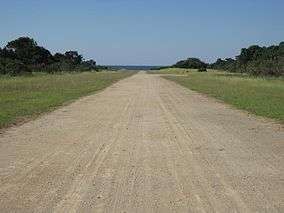Rubondo Island National Park
| Rubondo Island National Park | |
|---|---|
|
IUCN category II (national park) | |
|
Rubondo Airstrip | |
 | |
| Location |
Lake Victoria, |
| Coordinates | 2°18′S 31°50′E / 2.300°S 31.833°ECoordinates: 2°18′S 31°50′E / 2.300°S 31.833°E |
| Area | 456.8 km² |
| Established | 1965 |
| Visitors | 748 (in 2012[1]) |
| Governing body | Tanzania National Parks Authority |
Rubondo Island National Park is one of two Tanzanian National Parks located on an island in Lake Victoria (the other being Saanane Island National Park). The island attracts a small number of visitors each year, mainly game fishermen and bird enthusiasts.
Geography
Rubondo Island is located in the south-western corner of Lake Victoria, Tanzania. Rubondo Island is about 150 km (93 mi) west of Mwanza. The main island, Rubondo (2o 18’ S, 31o 50’ E) is 237 km2 in size. The island protects another 11 islets, none much larger than 2 km2.[2] These 10 islands form the Rubondo Island National Park covering an area of 456.8 km2 (176.4 sq mi). Lake Victoria is 1,134 metres above sea level. The highest point on Rubondo is the Masa Hills in the far south, at an elevation of 1,486m (350m above the level of the lake).[2] The main island measures 28 km from north to south and is 3–10 km wide. Rubondo Island is on a rift in the lake. Rubondo essentially consists of a partially submerged rift of four volcanically formed hills, linked by three flatter isthmuses.[2] The island has no rivers and the soil is volcanic.[3] The habitat is mixed evergreen and semideciduous forest, which covers about 80% of the island’s surface area with common species including Croton sylvaticus, Drypetes gerrardii, and Lecaniodiscus fraxinifolius, and often with a dense understory of lianas, or woody vines.[4] The forest is interspersed with patches of open grassland and, all but restricted to the Lukaya area, acacia woodland.[2] The eastern lakeshore is characterised by rocky areas and sandy beaches whilst the western shore supports extensive papyrus swamps, lined with date palms.[2]
Climate
There is a bimodal rainfall distribution, with peaks in December and April–May during the October–May rainy season. The annual temperature is 19–26 0C.[3]
History
Rubondo Island became a game reserve in 1965, to provide a sanctuary for animals.[5] Rubondo Island was gazetted as a national park in 1977. Today Rubondo is uninhabited. Consequently, 80% of the island remains forested today. The 400 “fisher folk”, who lived on the island and maintained banana plantations, were resettled on neighbouring islands and onto the mainland by the government in the late 1960s.[6] As a rule the court passed sentences of six weeks imprisonment for unauthorised landings on the island and six months for attempted poaching[6] (for example, see the story by Idogu on a group of fishermen caught poaching on the island in 1994 at http://www.flickr.com/photos/idogu/819509281/).
Fauna

Over a four-year period (1966–1969) Professor Bernhard Grzimek of the Frankfurt Zoological Society (FZS) released 17 chimpanzees in four cohorts onto Rubondo Island.[7] The first cohort of chimpanzees arrived in Dar es Salaam aboard the German African Line’s steamship Eibe Oldendorff on 17 June 1966 (Standard Newspaper Tanzania, 1966). The animals had no rehabilitation or pre-release training. The chimpanzees were all wild-born and purportedly of West African descent,[6] although there are no records of specific country of origin for the majority of released individuals.[8] The founder chimpanzees had spent varying periods, from 3.5 months to 9 years, in captivity in European zoos or circuses before their release.[9] The chimpanzees after one year were able to find and eat wild foods and construct nests for sleeping, and have now reverted to an unhabituated state characteristic of wild chimpanzees.[7] From 16 founders the population has now grown to around 40 individuals (estimate based on nest counts).[4]
In addition to chimpanzees, seven other species were introduced to the island: Roan antelope (Hippotragus equinus) and rhinoceros (Diceros bicornis) both now extinct, Suni antelope (Neotragus moschatus), elephants (Loxodonta africana), twelve giraffes (Giraffa camelopardalis), 20 black-and-white colobus monkeys (Colobus guereza), and African grey parrots (Psittacus erithacus) confiscated from illegal trade; see .
Chimpanzee research and Tourism
In 2012-2014 a research group from University College London undertook a study of the Rubondo chimpanzees. Since 2015 Tanzania national park managers have been running a chimpanzee habituation project. The hope is that one day it will be possible to reliably view the Rubondo chimpanzees. As of 2016 it is still not possible to see the Rubondo chimpanzees as a visitor.
Common native fauna include the vervet monkey (Chlorocebus aethiops), sitatunga (Tragelaphus spekei), hippopotamus, genet and bushbuck (Tragelaphus scriptus).[6][7]
Sources
- ↑ "Tanzania National parks Corporate Information". Tanzania Parks. TANAPA. Retrieved 22 December 2015.
- 1 2 3 4 5 Briggs, P. (2006). Tanzania. Bradt Travel Guide 5th edition. Pages 231-239.
- 1 2 Matsumoto-Oda, A. (2000). "Chimpanzees in the Rubondo Island National Park, Tanzania." Pan Africa News 7 (2).
- 1 2 Moscovice, L.R., Issa, M.H., Petrzelkova, K.J., Keuler, N.S., Snowdon, C.T., Huffman, M.A. (2007). "Fruit Availability, Chimpanzee Diet, and Grouping Patters on Rubondo Island, Tanzania." American Journal of Primatology, volume 69: 1-16.
- ↑ Matsumoto-Oda, Akiko (2000). "Chimpanzees in the Rubondo Island National Park, Tanzania". Pan Africa News. 7 (2.).
- 1 2 3 4 Grzimek, B. (1970). Among Animals of Africa. Collins London. p. 11. ISBN 978-0-00-211851-4.
- 1 2 3 Borner, Monica (1988). "The rehabilitated chimpanzees of Rubondo Island". Oryx. 19 (3): 151–154. doi:10.1017/S0030605300025242.
- ↑ Muller, G (unpublished). auf Rubondo-Island, Tanzania: Eine Pilotstudie (Report). Anthropologisches Institut: Universitat Zürich. Check date values in:
|date=(help) - ↑ Hannah, A.C.; McGrew, W.C. (1991). Rehabilitation of captive chimpanzees In: Box H.O., eds. Primate Responses to Environmental Change. London: Chapman & Hall. pp. 167–186.
External links
The official site of the Tanzania National Parks - Rubondo: http://www.tanzaniaparks.com/rubondo.html
- Tourism
The Tanzania Tourism http://www.tanzaniatourismonline.com/
